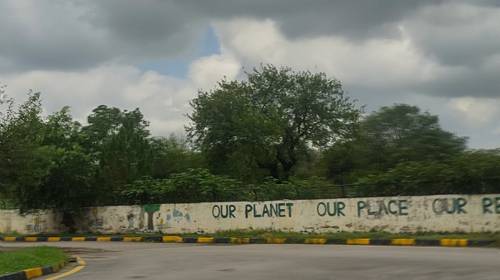
FAQ About The Evolution of Protest Art in Environmental Movements

What is protest art in the context of environmental movements?
Protest art in environmental movements refers to artistic expressions created to promote awareness and provoke action regarding environmental issues. This form of art is often used to highlight the threats posed by environmental degradation, such as pollution, deforestation, and climate change, and to call for political and social change. It typically includes various art forms like murals, posters, installations, and performances that convey powerful messages to the public and policymakers.

How has protest art evolved in environmental movements over the years?
Protest art in environmental movements has evolved significantly over the years, growing in both scope and visibility. In the early stages, such as the 1960s and 1970s, artists often focused on local environmental issues through traditional mediums like paintings and posters. As environmental awareness and activism grew, artists began employing a wider range of media, including digital platforms, street art, and interactive installations. Today, protest art often incorporates modern technologies such as augmented reality and social media, allowing for broader participation and dissemination of environmental messages.

Who are some notable artists known for their work in environmental protest art?
Several artists have made significant contributions to environmental protest art. Banksy, an anonymous street artist, is known for using public spaces to raise awareness about environmental issues through satirical and thought-provoking graffiti. Another influential artist is Agnes Denes, who is recognized for her large-scale environmental installations, such as the Wheatfield—a Confrontation, which challenged the priorities of urban development in New York City. Additionally, Olafur Eliasson and his works like Ice Watch, which brings awareness to climate change through melting ice installations, have had a profound impact on the environmental art movement.

What impact has protest art had on environmental policy?
Protest art has played a pivotal role in shaping environmental policy by raising public awareness and inspiring action. Artworks like those depicted in campaigns can mobilize communities and generate media attention, which puts pressure on policymakers to address environmental issues. For example, large-scale public art projects have drawn attention to the importance of conserving natural resources and combating climate change, often serving as a catalyst for policy discussions and legislative change. Furthermore, protest art can serve as an accessible medium for communicating complex environmental issues, encouraging public discourse and understanding.

Can protest art influence public awareness of environmental issues?
Yes, protest art can significantly influence public awareness of environmental issues. By presenting information in a visually compelling and emotionally engaging way, it captures the public's attention more effectively than traditional methods. This art form appeals to a broad audience and encourages contemplation and conversation about pressing environmental concerns. Through its ability to communicate complex ideas emotionally and symbolically, protest art has the power to stay in the public consciousness and inspire collective action and awareness.

What are some key examples of protest art in environmental movements?
Key examples of protest art in environmental movements include the 'Wheatfield—A Confrontation' by Agnes Denes, which transformed a landfill into a two-acre wheat field in Manhattan, symbolizing the conflict between nature and urbanization. Another powerful piece is the 'Ice Watch' by Olafur Eliasson, featuring melting ice blocks from Greenland arranged in public spaces to visually demonstrate climate change. Additionally, the posters and prints by the Green Patriot Posters project have been influential in spreading messages about sustainability and ecological responsibility across various cities.

How does protest art differ from other forms of environmental activism?
Protest art differs from other forms of environmental activism primarily through its use of creative and visual communication. Unlike traditional activism, which may involve petitions, protests, or legal action, protest art seeks to engage the public emotionally and intellectually by encapsulating powerful messages in artworks. While other activist methods focus on direct social and political engagement, protest art emphasizes symbolism, creativity, and public interaction to provoke thought and consciousness about environmental issues.

What role do digital platforms play in modern environmental protest art?
Digital platforms play a crucial role in modern environmental protest art by providing artists with innovative tools for creation and dissemination. Such platforms enable artists to reach global audiences instantaneously and engage with them interactively. Social media channels, in particular, allow artworks to be shared widely, enhancing their potential impact and fostering a community of environmentally conscious individuals. Additionally, digital art forms such as virtual reality, augmented reality, and digital installations expand the possibilities for interactive and immersive protest art experiences.

How has community participation influenced protest art in environmental movements?
Community participation has greatly influenced protest art in environmental movements by increasing its reach and relevance. Through participatory art projects, communities can contribute directly to the creation of artworks, ensuring that local issues and perspectives are represented. This collaborative approach not only empowers individuals but also strengthens community bonds and creates a sense of collective responsibility toward environmental conservation. Moreover, community-driven art initiatives can mobilize participants to become advocates and provide sustainable, grassroots support for environmental causes.

Are there any challenges faced by protest artists focusing on environmental issues?
Protest artists focusing on environmental issues face several challenges. One significant challenge is balancing artistic expression with political messaging in a way that resonates with audiences and maintains artistic integrity. Additionally, artists may encounter logistical issues such as limited funding, restrictive public policies on public art displays, and the transient nature of many environmental art installations. Furthermore, they must navigate the complexities of effectively engaging diverse audiences and avoiding oversaturation or desensitization to environmental themes due to repetitive displays.

What are some misconceptions about protest art in environmental movements?
One common misconception about protest art in environmental movements is that it is purely aesthetic and lacks substantial impact. In reality, protest art often plays a vital role in raising awareness and inspiring action, effectively communicating complex environmental issues through innovative visual storytelling. Another misconception is that protest art is only accessible or relevant to artists and art enthusiasts. On the contrary, it is designed to engage a wide audience and promote dialogue among diverse groups, including those who may not typically participate in environmental activism.

How do environmental movements select themes for protest art projects?
Themes for protest art projects in environmental movements are typically chosen based on the movement's goals and the specific environmental issues they wish to address. Artists and activists often collaborate to ensure that chosen themes effectively convey the urgency and importance of the topics. Factors such as current environmental events, public sentiment, and geographical relevance are considered when selecting themes. The selection process also involves evaluating the potential impact of the artwork in inspiring action and fostering public awareness.

What mediums are commonly used in environmental protest art?
Environmental protest art employs a variety of mediums to convey its messages, including traditional forms like paintings, drawings, and murals. More contemporary mediums such as digital art, video projections, and photography are also widely used. Public installations, sculptures, and performance art provide tangible and immersive experiences. Additionally, artists increasingly utilize temporary, biodegradable, or recycled materials to highlight themes of sustainability and ecological consciousness within their artworks.

How has the use of technology influenced protest art in environmental movements?
Technology has significantly influenced protest art in environmental movements by expanding creative possibilities and amplifying reach. Artists leverage digital tools to create, edit, and share their work, allowing them to engage with a larger audience online. Technologies like virtual reality and augmented reality have introduced new dimensions to protest art, offering immersive experiences that deepen viewers' understanding of environmental issues. Additionally, technology facilitates collaboration across distances, enabling artists from different regions to co-create and innovate in their art forms.

What is the relationship between protest art and environmental education?
Protest art and environmental education often work hand in hand to raise awareness and understanding of ecological issues. Through visually engaging and thought-provoking artworks, protest art serves as an educational tool that simplifies the complexity of environmental topics and stimulates public interest. It creates opportunities for discussions, workshops, and interactive sessions that deepen viewers' understanding and encourage them to learn more about the topics depicted. This synergy between art and education fosters an informed and active public that is better equipped to advocate for environmental change.

How do protest art installations convey messages about climate change?
Protest art installations convey messages about climate change by visually representing its impacts and urging societal reflection and response. Artists use symbolism, scale, and location to create powerful statements about the urgency and scope of climate change. Installations often incorporate elements like melting ice, rising sea levels, or distorted landscapes to depict the consequences of global warming. By situating these installations in public spaces, artists make the abstract concept of climate change tangible and immediate, engaging viewers and motivating action and dialogue.

What role does symbolism play in protest art within environmental movements?
Symbolism plays a crucial role in protest art within environmental movements as it allows artists to convey complex messages and emotions through imagery. Symbols such as water, trees, and endangered animals are often used to represent broader environmental themes like conservation, pollution, and biodiversity. By employing universally recognizable symbols, artists can communicate urgent issues effectively and evoke an emotional response from the audience. Symbolism facilitates a deeper connection between the artwork and the viewer, enhancing the movement's message and impact.

How have past environmental crises influenced protest art?
Past environmental crises have significantly influenced protest art by providing both inspiration and urgency for creators. Events such as the Exxon Valdez oil spill and the Fukushima nuclear disaster have prompted artists to depict the devastating consequences of these crises and advocate for preventive measures. These artworks serve as historical records and catalysts for public discourse, reminding audiences of the ongoing threats to the environment. By reflecting on past crises, protest art helps maintain a critical awareness of environmental challenges and the need for continued vigilance and advocacy.

What is the significance of location in protest art displays?
The significance of location in protest art displays lies in its ability to contextualize and amplify the artwork's message. By placing art in strategic public locations, artists can target diverse audiences and prompt spontaneous engagement from passersby. Location can also enhance the artwork's symbolism; for example, installations depicting rising sea levels may be placed near coastlines or urban waterfronts to underline their proximity and relevance. The choice of location contributes to the artwork's impact and accessibility, facilitating direct public dialogue about environmental issues.

How can protest art provoke action in environmental movements?
Protest art can provoke action in environmental movements by eliciting emotional responses and creating a sense of urgency among viewers. By presenting environmental issues in a powerful and relatable manner, protest art motivates individuals to reflect on their personal impact and encourages them to participate in advocacy, whether through attending protests, supporting policy changes, or adopting more sustainable practices. The visibility and emotional appeal of protest art can also spur collective action by galvanizing communities to organize around specific causes and campaigns.
